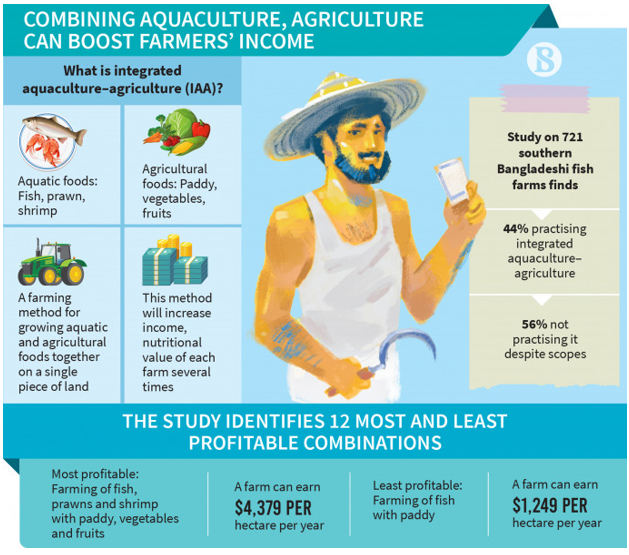Bangladesh: About 56% of fish farms in the country's southern region are not practising integrated aquaculture-agriculture (IAA), the farming of aquatic foods such as fish, prawn, and shrimp with agricultural foods such as paddy, vegetables and fruits despite having the scope and space to do so, finds a recent study.

Infographic credit: TBS
The IAA is a form of crop diversification where aquatic and terrestrial foods are grown together on a single piece of land, which according to the study could increase the income and nutritional value of each farm several times.
The study titled "Integrated Aquatic and Terrestrial Food Production Enhances Micronutrient and Economic Productivity for Nutrition-sensitive Food Systems" was published in the journal Nature Food on 4 September. Researchers conducted the study, funded by USAID, on 721 fish farms in Southern districts of Bangladesh and compared economic and nutrient productivity per hectare of land.
According to the study report, around 44% of these farms were found producing other agricultural products alongside doing aquaculture on the same land. These firms are growing fish, prawns and shrimps alongside paddy, vegetables and fruits based on 12 distinct IAA combinations. However, not all those who are doing integrated agriculture are able to earn very well, but it is possible to earn more by cultivating diversified agricultural products with aquaculture, the report says.
Researchers have also identified the most and least profitable models among the 12 integrated agriculture models. The study calculated economic productivity per hectare per year by analysing the models. Among these, the most profitable model has been found where a farm integrated farming of fish, prawns and shrimp with paddy, vegetables and fruits. Such farms earn USD 4 379 per hectare per year. Those farms with integrated farming of fish and prawns with paddy, vegetables and fruits earn USD 3 947.The least economically productive model has been where farms integrated farming of fish with paddy and earn USD 1 249 and farms with fish with paddy, vegetables and fruits earn USD 1 335.
It is widely recognised that producing more diverse foods can improve the nutritional status of smallholder households, either by providing nutritious foods for them to consume or by providing foods for sale, the earnings from which can be used to buy nutritious food, the study report said. It said that farmers who are earning less through combined farming and those who are not practising combined farming also have an opportunity to increase their income and thereby increase their nutritional intake, it said. The researchers said it is possible to increase the production of firms by diversifying these IAA models further, an initiative that should be spread to firms through policymakers. This study was funded by Feed the Future Innovation Lab for Fish, through the United States Agency for International Development (USAID) and is part of the CGIAR Initiative on Asian Mega Deltas.
Dr Liz Ignowksi, a postdoctoral fellow at WorldFish and the paper's lead author, said: "Our study introduces a new nutrition-sensitive metric for agricultural productivity. This approach allows us to explore the relationship between economic and nutrient productivity across a range of existing farming systems in southwest Bangladesh. “The results provide an intuitive measure of nutrient sensitivity that may be easily understood by researchers and policymakers and mobilized by development practitioners and food producers," Liz added. The study found that, among aquatic food combinations, production of only fish is most common at 39%, followed by fish, prawn and shrimp at 29%, fish and prawn at 26%, and fish and shrimp at 8%. Among the studied households, 96% produce some carp species, 83% produce unstocked fish species, 82% produce other stocked fish and 59% produce crustaceans.
Hazrat Ali, a PhD student at Bangladesh Agricultural University and senior research analyst with WorldFish, said, "Our approach can be used to identify possible improvements to farming practices such as facilitating the entry of nutritionally and economically productive unstocked fish species into ponds or identifying suitable candidate fish species for domestication via investments in fish breeding research. “However, researchers said the IAA models do not work in high-salinity areas, but they will play an effective role in medium and low-salinity areas. The study found that farms, where aquaculture is integrated with terrestrial crop production, tend to produce larger quantities of a broader range of nutrients than farms producing only fish. Some aquatic foods like shrimp are associated with higher incomes but don't supply many nutrients. Some other crops like green leafy vegetables, okra, gourds, long beans, coconuts, and fish species such as puti (freshwater burb), tengra (indigenous catfish) and catla (Indian Major Carp) make particularly important contributions to micronutrient supply, and can also generate incomes, the study revealed.
Dr Ben Belton, a research fellow at IFPRI, said: "We find strong empirical evidence that production diversity associated with the integration of aquatic and terrestrial foods can be beneficial for both economic and nutrient productivity for smallholder farmers."
Source: TBS News; Dated: 12 September 2023.

